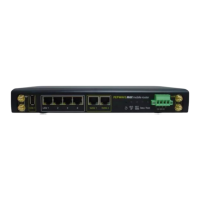NAT Mapping rules can be defined for a single LAN IP Address, an IP Range, or an IP
Network.
This refers to the LAN host’s private IP address. The system maps this address to a number
of public IP addresses, specified below, in order to facilitate inbound and outbound traffic.
This option is only available when IP Address is selected.
The IP range is a contiguous group of private IP addresses used by the LAN host. The system
maps these addresses to a number of public IP addresses, specified below, to facilitate
outbound traffic.
This option is only available when IP Range is selected.
The IP network refers to all private IP addresses and ranges managed by the LAN host. The
system maps these addresses to a number of public IP addresses, specified below, to
facilitate outbound traffic.
This option is only available when IP Network is selected.
This setting specifies the WAN connections and corresponding WAN-specific Internet IP
addresses on which the system should bind on. Any access to the specified WAN
connection(s) and IP address(es) will be forwarded to the LAN Host.
This option is only available when IP Address is selected in LAN Client(s) field.
Note 1: Inbound Mapping is not needed for WAN connections in drop-in or IP forwarding
mode.
Note 2: Each WAN IP address can be associated to one NAT Mapping only.
This setting specifies the WAN IP addresses should be used when an IP connection is made
from a LAN host to the Internet.
Each LAN host in an IP range or IP network will be evenly mapped to one of each selected
WAN's IP addresses (for better IP address utilization) in a persistent manner (for better
application compatibility).
Note 1: If you do not want to use a specific WAN for outgoing accesses, you should still
choose default here, then customize the outbound access rule in the Outbound Policy section.
Note 2: WAN connections in drop-in or IP forwarding mode are not shown here.
Inbound firewall rules override the Inbound Mapping settings.

